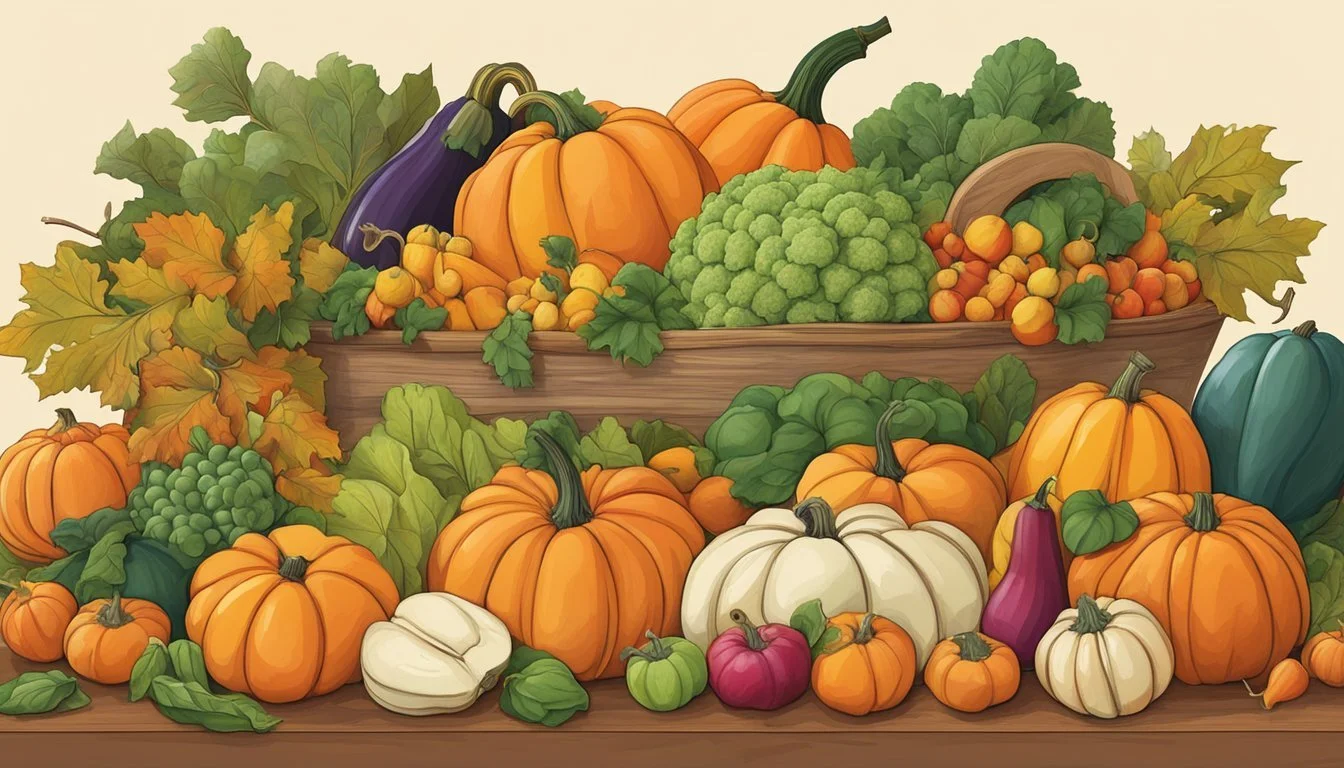Kansas Seasonal Fruit & Vegetables in November
Your Guide to Fresh Produce
This Article is Part of our Kansas Seasonal Fruit & Veg Calendar
In November, the rich soils of Kansas yield a variety of produce despite the cooler temperatures. Seasonal eating is embraced in this region, where the emphasis is on consuming fruits and vegetables at the peak of their freshness and nutritional value. The fall harvest brings a bountiful selection that not only supports local agriculture but also offers consumers nutrient-dense options to enhance their diets.
Among the produce available, robust root vegetables like carrots, sweet potatoes (What wine goes well with sweet potatoes?), and turnips take center stage. These vegetables are not only versatile in the kitchen but also high in vitamins and minerals. Kansas' November harvest also includes cruciferous vegetables such as broccoli (how long does broccoli last?)and cauliflower (how long does cauliflower last?), which are lauded for their health benefits.
Leafy greens like kale and spinach remain in abundance, and while the fruit selection narrows, apples (how long do apples last?) stored from the recent fall harvest continue to be crisp and flavorful. Eating seasonally in November allows Kansans and visitors alike to enjoy fresh, locally grown produce that contributes to a sustainable food system and a healthy lifestyle.
Overview of Kansas Seasonality
In Kansas, the transition between the fall harvest and the onset of winter influences the availability of fresh seasonal produce. By November, winter is approaching, and this change is reflected in the crops that are accessible to consumers.
Fall crops linger into November, with some varieties weathering the cooler temperatures. Frost-resistant vegetables like cauliflower may still be available, depending on the year's specific weather patterns. Similarly, root vegetables, which are generally robust against colder temperatures, remain in season. These include produce such as celeriac or celery root.
During this period, harvest times for the late-season crops are wrapping up. It is a time when Kansas farmers may gather the last yields of the year's produce.
Below is a brief display of typical crop availability and harvest times relevant to November in Kansas:
Cauliflower: August - November
Celeriac/Celery Root: August - October
The farming community anticipates the shift in seasons as they prepare for winter. They implement methods to protect the remaining crops from early frosts and utilize greenhouses or cold storage to extend the availability of certain vegetables.
Understanding crop availability through the seasons equips consumers with the knowledge to make informed choices and support local agriculture. As a result, Kansans can enjoy fresh, nutrient-rich produce that correlates with the natural growing cycle of their region.
Fruits in Season
In November, certain fruits reach their peak in Kansas, offering rich flavors and nutritional benefits. These fruits are commonly used in various recipes, enhancing the seasonal cuisine.
Apples
Variety: Granny Smith apples are abundant during November. Known for their vibrant green color and tart flavor, they are ideal for both eating raw and for cooking.
Nutrition: These apples are high in fiber and vitamin C, contributing to a healthy diet.
Recipes: Granny Smiths are often used in pies, crisps, and salads for a refreshing, acidic balance.
Pears
Flavor: Pears available in Kansas during November offer a sweet and buttery flavor, becoming especially juicy when fully ripe.
Nutrition: They are a good source of dietary fiber and vitamin C.
Recipes: Pears are versatile, fitting well into baked goods, poached pear recipes, or simply eaten fresh.
Persimmons
Variety: The persimmon fruit, while less common, is a seasonal delight with a sweet and honeyed flavor profile, which can vary from astringent to non-astringent depending on the type.
Nutrition: Persimmons are rich in vitamins A and C and contain beneficial antioxidants.
Recipes: They can be used in desserts, such as puddings and cakes, or eaten on their own once ripe.
Vegetables in Season
Kansas’s markets in November are abundant with a variety of seasonal vegetables, offering rich flavors and essential nutrients. Shoppers can find an array of fresh produce that includes root vegetables, cruciferous vegetables, and leafy greens, all harvested at their peak.
Root Vegetables
Root vegetables thrive in the cooler temperatures of a Kansas November. The selections include:
Beets: Vibrant and versatile, beets are rich in flavor and nutrients.
Carrots: A staple in any kitchen, carrots harvested at this time are particularly sweet.
Turnips: These often-overlooked vegetables are perfect for roasting or mashing.
Sweet Potatoes: A sweeter alternative to traditional potatoes and a Thanksgiving favorite.
Cruciferous Vegetables
Known for their health benefits and hearty structures, the following cruciferous vegetables are readily available:
Cabbage: Found in several varieties, cabbage is a versatile addition to both raw salads and cooked dishes.
Broccoli: High in vitamins, broccoli is ideal for steaming or enjoying in a stir-fry.
Brussels Sprouts(how long do brussels sprouts last?) : Small but packed with flavor, these are often roasted to emphasize their nutty taste.
Cauliflower: This vegetable can be mashed, roasted, or used as a low-carb substitute in many recipes.
Leafy Greens
Leafy greens flourish in the cooler climate, gracing salads and warm dishes with their textures and flavors:
Arugula: With its peppery kick, arugula adds a punch to salads and pizzas.
Spinach: This versatile green is nutrient-dense, perfect both raw and cooked.
Kale: Robust and nutrient-rich, kale can be used in salads, soups, and chips.
Swiss Chard: With colorful stems and a hearty texture, Swiss chard is an excellent choice for a warm autumn sauté.
Herbs in November
In Kansas, the month of November is a pivotal time for herb enthusiasts to focus on certain resilient herbs that thrive despite the cooler temperatures. These herbs can provide robust flavor to a variety of seasonal dishes.
Savory Herbs
Cilantro: Known for its fresh and tangy flavor, Cilantro can still flourish in the cooler November climate of Kansas. It's a favorite in salsas and as a garnish for various dishes.
Parsley: Hardy and versatile, Parsley withstands the colder days well and continues to impart a mild, herby flavor that complements soups and stews.
Garlic: Although typically planted in the fall, Garlic matures over the winter for a summer harvest. In the meantime, November is ideal for utilizing stored Garlic from previous seasons to enhance savory dishes.
Aromatic Herbs
Dill (how long does dill last?): With its soft, feathery leaves and sweet aroma, Dill can be harvested in November. It's often added to pickles, fish, and potato salads.
Basil: While Basil is sensitive to cold, it can still be grown in a protected kitchen garden or indoors. Its sweet, peppery flavor is essential for pesto and a wonderful accent for tomato-based recipes.
Garlic Scapes: Those with Garlic from the spring planting might find Garlic Scapes available. These are the tender, milder flowering stems of the garlic plant, great for making subtly flavored pestos and stir-fries.
Preparation and Recipes
In November, Kansas gardens yield a bountiful harvest perfect for wintry comfort foods. Root vegetables like carrots and parsnips can be transformed into warm, hearty meals. Cauliflower and cabbage offer versatility, fitting for side dishes or mains.
Roasted Root Vegetables A simple, yet flavorful preparation is roasting. It caramelizes the natural sugars, enhancing the taste of carrots, parsnips, and squash.
Preheat the oven to 425°F (220°C).
Peel and chop vegetables into uniform pieces.
Toss with olive oil, salt, and pepper.
Roast for 25-30 minutes or until tender.
Creamy Cauliflower Soup When it comes to cauliflower, a creamy soup is quintessential for November's crisp days.
Ingredients:
1 large cauliflower, chopped
1 large onion, diced
4 cloves garlic, minced
Vegetable stock
Cooking Technique:
Sauté onions and garlic until translucent.
Add cauliflower and stock; simmer until soft.
Blend until smooth; season to taste with salt and pepper.
Cabbage and Apple Slaw Cabbage shines in slaw, an easy side dish that pairs well with various mains.
Ingredients:
1 medium cabbage, shredded
2 apples, julienned
Carrots, shredded (optional for extra color and crunch)
Dressing: olive oil, apple cider vinegar, mustard (how long does mustard last?), honey, salt, and pepper
Instructions:
Combine cabbage and apples in a bowl.
Whisk dressing ingredients and toss with the slaw.
These recipes showcase the simplicity and heartiness of seasonal dishes, letting the natural flavors of the November harvest take center stage.
Health Benefits of Seasonal Eating
Eating seasonally is associated with numerous health benefits that are important to consider. Nutrition experts recognize that seasonal fruits and vegetables are often more nutrient-dense. This is due to the fact that they are harvested at their prime and do not require long storage periods, which can deplete vitamin content.
Additionally, seasonal produce tends to be fresher and, as a result, offers a higher concentration of antioxidants. These compounds are crucial in combating oxidative stress, which can lead to chronic diseases. A variety of fruits and vegetables in the diet enhances the diversity of nutrients one consumes, which can improve overall health.
Here's a summary of key benefits:
Fresher produce: Higher levels of vitamins and antioxidants.
Peak flavor: Encourages consumption and enjoyment of healthy foods.
Support for the local economy: Seasonal foods are often sourced from local farms.
Nutrient Benefit Vitamins Enhances immune function Minerals Supports bone health and blood formation Fiber Aids in digestion and satiety Antioxidants Reduces the risk of chronic disease
By opting for seasonal foods, individuals also consume a variety of produce, which is important for a balanced diet. Seasons naturally rotate the available nutrients, thus fostering a more complete dietary profile over the course of the year. This variety is not just beneficial for one's physical health, but it is also known to enhance one's culinary experience, making meals more enjoyable.
Farming and Harvest Practices
In Kansas, farmers adhere to a schedule that aligns with the shifts in season to ensure that the produce is both sustainable and of high quality. During November, the focus shifts to late-season crops that are suited to the cooler temperatures. Farmers utilize crop rotation and cover cropping strategies to optimize soil health.
Pruning is a crucial farming practice that enhances the health and yield of certain fruit trees and bushes. By November, pruning is generally completed for the year, or farmers are preparing for winter pruning. This involves removing dead or diseased branches, shaping the plant, and controlling its size to improve sunlight penetration and air circulation.
Harvest Time for November Crops Typical Produce Early November Brussels sprouts, winter squash Mid November Sweet potatoes, pumpkins Late November Kale, cauliflower
Farmers are diligent with their harvest times to ensure fruits and vegetables are picked at peak ripeness for the best flavor and nutritional content. Root vegetables such as carrots and beets may stay in the ground a bit longer, taking advantage of the natural insulation against early frost.
Storage also plays a significant role. Farmers employ methods like curing sweet potatoes to enhance durability, allowing for extended availability through the winter months. The produce harvested in November contributes to both immediate consumption and long-term storage, providing a continuous supply of fresh, local food.
Finding Seasonal Produce
In Kansas, November marks the end of the fall harvest, offering a bounty of late-season produce. Locating these fruits and vegetables is an easy venture thanks to the abundant farmers' markets scattered across the state. Consumers can rely on these markets as reliable sources for fresh, local produce.
Farmers' Markets:
Shoppers can visit various farmers' markets to find seasonal goods. They serve as community hubs where local farmers present their freshest crops. Each market typically has its own schedule but most are open through November, weather permitting.
Kansas Produce Map:
A useful tool for residents and visitors is the Kansas produce map. This resource provides detailed information on where and when to find seasonal fruits and vegetables across the state.
Seasonal Availability Table
The following table highlights typical Kansas produce available in November:
Fruits Availability Apples Peak Season Pears Ending Soon Persimmons Just Starting
Vegetables Availability Brussels Sprouts In Season Cabbage In Season Carrots In Season Sweet Potatoes In Season
Visitors should note that, while the above produce is generally available, factors such as weather and growing conditions may affect availability. Kansas prides itself on its agricultural heritage; therefore, consumers are encouraged to take advantage of the state's seasonal offerings for the freshest experience.
Storing and Preserving
In Kansas, November marks a transition period where gardeners and consumers shift their focus to storing and preserving the harvest for the coming months. There are efficient techniques to extend the shelf life of the autumn bounty, ensuring a steady supply of fruits and vegetables.
Storing Techniques:
Root Vegetables: Carrots and celeriac can be kept in humid, cool conditions, such as a root cellar or a storage area where temperatures hover around 32-40°F (0-4°C).
Apples: For apples, which are among the few fruits still available, proper storage in a refrigerator or cool garage can maintain freshness for weeks.
Preservation:
Canning: Capturing the flavors of late fall produce, such as apples and root vegetables, can be achieved through canning. Ensuring all canning procedures follow safety guidelines is imperative to prevent foodborne illnesses.
Pickling: Cucumbers transformed into pickles is a classic example, and the practice can apply to a variety of produce, providing tangy treats that last well into winter.
Fermentation: Fermenting vegetables like cabbage into sauerkraut contributes to a rich probiotic profile and can be stored in a cool, dark place.
It’s essential to keep preserved foods labeled and dated. Monitor your preserved items periodically for any signs of spoilage, and consume stored produce in a timely fashion to enjoy their best quality.
Seasonal Eating Tips
In Kansas, November ushers in a bountiful period for certain fruits and vegetables, where farmers' markets and local grocery stores brim with a variety of seasonal produce. Eating seasonally not only supports local agriculture but can also enhance one's nutrition due to the higher content of vitamins and minerals in produce that's harvested at its peak of ripeness.
A few nutrient-rich November offerings include:
Broccoli: Rich in vitamins C and K
Carrots: High in beta-carotene and fiber
Cauliflower: Offers vitamins C and K, and folate
Sweet Potatoes: Loaded with vitamin A and potassium
These vegetables can be incorporated into a myriad of recipes, transforming them into warm, comforting dishes suited for the cooler November climate. For instance, roasted vegetables like carrots and sweet potatoes can add depth and sweetness to soups and stews. Moreover, cauliflower can be prepared in various creative ways, from being mashed as a low-carb substitute for potatoes to being included in a savory curry.
Here is a simplified guide to November produce shopping:
Vegetables Nutritional Highlights Recipe Ideas Broccoli Vitamins C and K, Fiber Broccoli Soup, Roasted Broccoli with Garlic Carrots Beta-carotene, Fiber Carrot-Ginger Soup, Glazed Carrots Cauliflower Vitamins C and K, Folate Mashed Cauliflower, Cauliflower Rice Sweet Potatoes Vitamin A, Potassium Sweet Potato Casserole, Baked Sweet Potatoes
Consumers should feel confident to explore the local markets to find the freshest seasonal produce. By choosing to eat seasonally, one not only obtains the best flavors and nutritional value but also encourages sustainability and the local economy.











